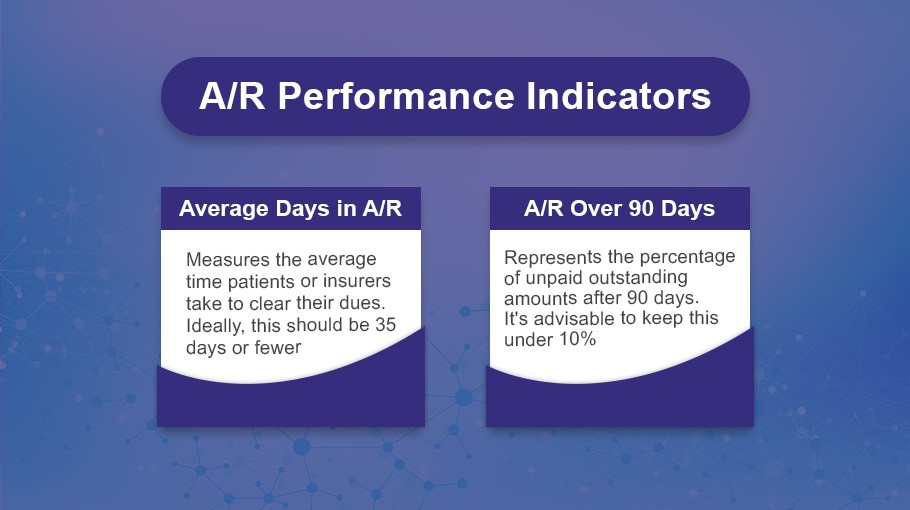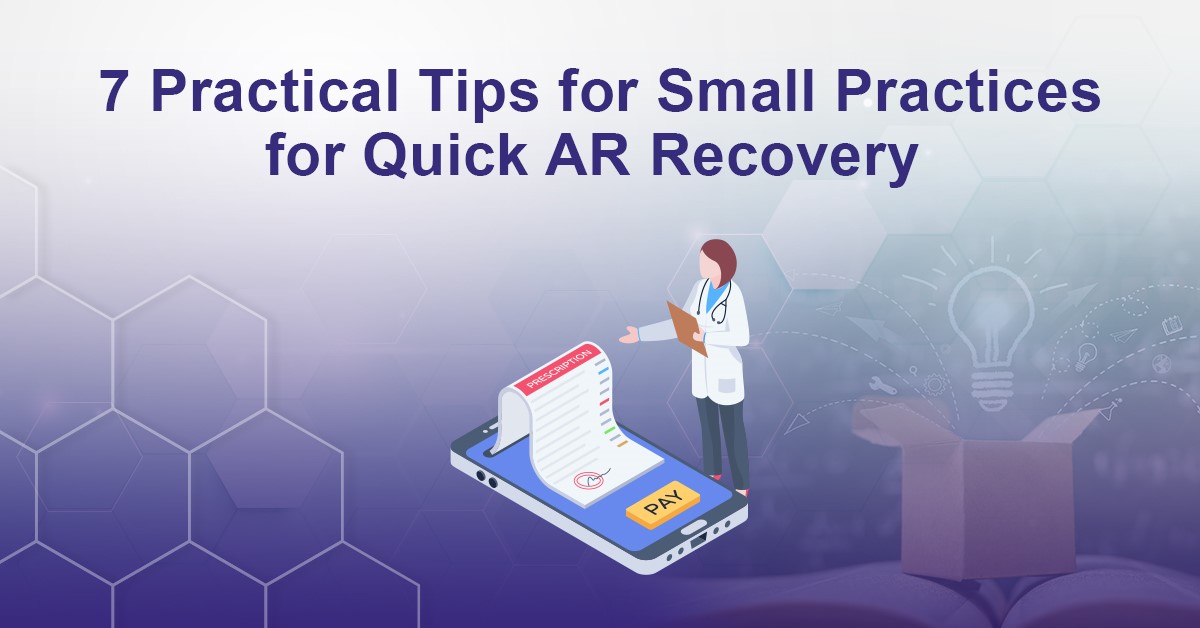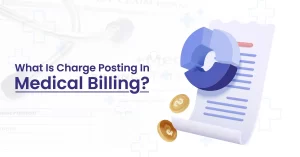Small practices often grapple with managing their Accounts Receivable (AR). Ensuring quick AR recovery is not just about getting payments on time; it’s about building sustainable patient relationships, maintaining operational efficiency, and, most crucially, safeguarding the financial pulse of the practice. If you’re a small healthcare practice seeking to improve your AR recovery rate, this guide is tailor-made for you.
Understanding Account Receivables
Accounts Receivable (A/R) in healthcare refers to the outstanding amounts owed to a healthcare provider, a local clinic, a physician’s office, or a larger hospital. This usually comprises unpaid patient bills and insurance company reimbursements.
The A/R Process
Billing and Claim Initiation
Once a patient receives medical care, your practice generates a bill or, if they have insurance, submits a claim to their health insurer.
A/R Stage
From the moment the bill is generated or the claim is submitted until the payment is received, the account remains in the A/R category.
Payment Completion
When the patient settles their bill, or the insurance company processes the reimbursement, that specific A/R is closed.

Age-Based A/R Categories in Healthcare RCM
1. 1-30 days
2. 31-60 days
3. 61-90 days
4. 91-120 days
5. Over 120 days
Why Should Small Practices Prioritize A/R?
For small healthcare practices, understanding and effectively managing A/R is crucial. Not only does it ensure a stable cash flow, but it also positions the practice for sustained growth and success.
Financial Health
A high A/R means money owed to you isn’t in your bank. This impacts cash flow, affecting the practice’s ability to function smoothly and compensate staff.
Risk of Non-payment
The longer an invoice remains unpaid, the harder it becomes to collect the total amount. Over time, these might become ‘bad debts,’ which are amounts you’ll likely never recover.
Operational Efficiency
Efficient A/R management ensures a healthier financial flow, enabling you to provide better services, invest in new equipment, and grow your practice.
7 Practical AR Recovery Tips for Small Practices

Managing accounts receivable is essential for the financial health of any business, but it’s especially pertinent for small practices that may not have vast resources. Streamlining and enhancing your AR recovery process can significantly boost your cash flow and profitability. Here are seven practical tips to improve AR recovery for small practices:
Prompt Action on Late Payments
Late payments can harm the cash flow of small practices. Ensuring timely payment for pending bills is essential to avoid any difficulty. Here’s what small practices should do to increase the A/R recovery process:
Timely Reminders
Start by sending reminders a few days before the payment is due. This can serve as a gentle prompt for clients or patients.
Consistent Follow-up
If payments are overdue, consistently follow up at regular intervals, such as every week or every 15 days. Being persistent without being aggressive can remind patients of their outstanding balances.
Clear Communication
Ensure your communication is clear, precise, and professional. Provide all relevant details related to the invoice, including the due date, the outstanding amount, and any applicable late fees.
Automate Your Payment Process
The payment process can be considerably improved by automation. Small practices should automate their payment process to reduce resource usage, decrease processing time, and speed up the entire process. Moreover, small practices can take these steps.
Billing Software
Invest in billing software that automatically sends out invoices, reminders, and alerts for late payments.
Recurring Payments
If appropriate, set up automatic deductions or recurring payments for clients with regular transactions.
Online Payment Portals
Integrate online payment portals that allow clients to settle their bills 24/7.
Enhance Follow-up on Collections
To receive the highest payment from the insurance companies, small practices must take care of denied claims and reopen them. Practices must keep on following up on collections. In this way, they can increase the A/R recovery. Practices must do these things to optimize the process more.
Designated Staff
Assign dedicated personnel to handle collections. Regularly training them ensures they approach the task effectively and professionally.
Focus Overdue Accounts
Have a straightforward procedure for focusing overdue accounts, such as involving a collections agency after a particular period.
Documentation
Maintain thorough records of all communications related to late payments.
Utilize EHR Systems for Transparency
Electronic Health Record Software (EHR) can help practices manage billing operations from patient registration to payment collection. Small practices should use EHRs for a swift A/R recovery process.
Patient History
Manage patient registration, details, payment history, and more using an electronic health record (EHR).
Notifications
Remain informed with modern EHRs like MediFusion that can automatically notify you of overdue accounts, ensuring none slip through the cracks.
Integration
Integrate your existing accounting or billing software for streamlined operations with an efficient EHR system like Medifusion.
Incentivize Your Payments
Small practices can improve the A/R recovery process by offering discount offers. They can offer various payment plans to provide patients with convenience. Practices should offer incentives on payment collections like:
Early Payment Discounts
Offer discounts to clients who pay their invoices before the due date.
Loyalty Programs
Consider setting up loyalty programs where consistent on-time payments earn points or rewards.
Transparent Communication
Communicate the benefits of early or on-time payments, emphasizing how it benefits both parties.
Enhance the Security for Safe Payments
Secure payment collection is the need for small practices. The practices must follow these steps to make the A/R recovery more secure and safe.
Secure Platforms
Use trusted and encrypted platforms for online payments.
Regular Updates
Ensure your payment systems are updated to guard against potential threats.
Educate Patients
Educate your patients on the importance of safe transactions and how to recognize potential red flags.
Multiple Payment Options for Convenience
Practices should not bind the patients only in one payment method. They must offer multiple payment options for patients’ convenience to enhance and increase the payment collection.
Multiple Options
Offer various ways to pay, such as credit cards, bank transfers, online payment gateways, or even digital currencies if viable.
Mobile Payments
Ensure your payment portal is mobile-friendly, as many clients prefer to pay via mobile devices.
Physical Payments
While digital is the way forward, catering to all your client’s needs is essential. Maintain an option for checks or cash payments, especially if a segment of your clientele prefers it.
By implementing these practical AR recovery tips, small practices can ensure steady cash flow, maintain positive patient relationships, and secure their financial health.
Conclusion
Managing Accounts Receivable is not just a financial practice but an art, especially for small healthcare establishments that often operate with limited resources. Ensuring that AR is effectively managed can distinguish between a practice that thrives and one that merely survives. By implementing the seven practical AR recovery tips outlined in this article, small practices can ensure a consistent cash inflow and foster patient trust, ensuring long-term relationships and practice growth.





